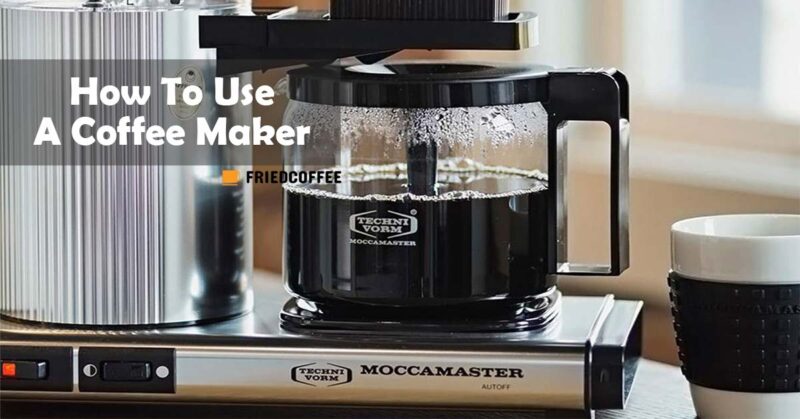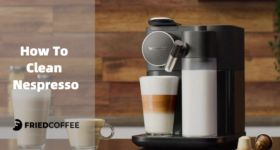
If a cup of steaming coffee is a primary participant in your daily routine, it’s likely that your local coffee shop barista is your best friend. It is also likely that your pocketbook has been bearing the brunt of your caffeine cravings.
Should you feel the want or need to have your caffeine creations be home-born, you’re going to need a few key ingredients and appliances added to your kitchen.
If you’re feeling a bit out of your depth and don’t know where to begin, get a few answers by taking a walk with us through the what’s hows and the whens of brewing a cup of coffee at home using a drip coffee maker.
How To Use A Drip Coffee Maker
In the words of good old Julia Andrews; ‘Let’s start at the very beginning, a very good place to start‘.
For anyone inducting themselves into the world of home coffee brewing, an automatic drip coffee maker is a very safe and smart option to turn to. The process is fairly simple to comprehend. You have the freedom to experiment with different types of coffee and you’re guaranteed reliable taste and quality every time you brew.

What You Need
- Coffee Beans – The obvious key ingredient. Get yourself the freshest bag of coffee beans you can lay your hands on.
- The coffee Maker – There are a number of different automatic drip coffee makers in the market. Do your research and find whatever suits the needs of you and your kitchen.
- A Digital Scale – If you want to be precise in brewing your morning cup, you’re going to need a scale. Once you’ve gone few days weighing out the quantity of coffee you’re adding in, you can ditch the scale. Then try to go freehand.
- Coffee Grinder – If your coffee bag carries whole beans, you’re going to need to grind them fresh each time before you brew.
- Water – Irrespective of which coffee machine you own; you’re going to need cold water for the reservoir that stores the water used in your coffee.
- A coffee filter – A lot of automatic drip coffee makers come with their own reusable coffee filters. If however yours doesn’t, you need to get your hands on a disposable one. A few coffee makers only run when their customized coffee filters are used. So be sure to figure out what kind of filter your coffee maker needs and have it ready.
- A spoon for measuring or a tool for stirring if required at any time.
- Your Coffee Mug – Whatever mug makes your coffee taste just that little bit special.
Steps to use a Coffee Maker
- Prepare your coffee maker – Set up your automatic drip coffee maker. Make sure it is clean.
- Place the coffee filter – If you’re using a disposable filter, make sure it is fitted properly. Prep the filter by folding the crimped edges in the opposite direction before placing it inside. Don’t settle for any ordinary low filter cheap filter as it could be the cause for your coffee tasting a little strange.
- Weigh the beans – Grab your kitchen scale and weigh out the coffee beans you’re going to need. The general rule of thumb is, the more coffee beans you put in, the more cups of coffee you get out.
- Grind – Set your grinder on a drip setting and get to work grinding. If your grinder does not have that option, set it to medium-fine particle size.
- Place ground coffee and fill water – Place the ground coffee into the filter and fill in the water reservoir with cold water.
- Turn your brewer on – All that’s left to do is plug the machine in, turn it on, and allow your coffee to brew. If you prefer to pick a particular strength setting at which your coffee brews, choose one that suits your taste.
- Wait – Once the machine is done, which should take anything between three and five minutes, pour the coffee out into your favorite cup. Sit back, sip, and enjoy.
- Clean the Coffee Machine – Never forget to clean out all the areas. If you’ve used a disposable filter, be sure to dispose of it. If not, clean out the reusable filter and wipe down all the necessary surfaces.
Here is a video tutorial for graphic lovers –
Things to Consider Before you Brew
There are a surprisingly large amount of elements that you would otherwise think inconsequential, that play a role in forming the end taste of your cup of coffee.
If you find something missing, or something wrong with your coffee despite following all the steps to a T, chances are a few tweaks in one of these areas will set everything right. Unlike a few other methods, using an automatic drip coffee maker allows you a certain level of freedom to control and alter these elements every time you brew.
Water Quality and Quantity
Since a large percent of brewed coffee is water it should not come as a surprise to you when we say you need to pay a little extra attention in this area. Don’t just throw in water from the tap into your machine and call it a day. Impurities from tap water alter the taste of your caffeinated drink. Tap water does also contain its fair share of minerals however that can enhance the taste of your coffee. As a solution, try and gain access to filtered or bottled water for your coffee.
The ratio of coffee to water will vary from one coffee drinker to the next. The universally agreed ratio is 15 grams of coffee for every 225 grams of water. If you’re using a spoon for quantity control, it will be one tablespoon of coffee to every six ounces of water. If you need the coffee stronger, you can reduce the quantity of water per cup of coffee you’re brewing. Alternatively, if you find the coffee too strong, try increasing the quantity of water in each cup.
Once you’ve given the automatic drip coffee maker a few runs, you might be tempted to experiment. If you find yourself in the mood for some of the chilled variants of coffee, you can brew a cup with less water and make up for the difference in the shape of ice cubes.
Cleaning and Upkeep
The way you look after any machine determines how long it’s going to live in your house and serve your needs. That being said, proper cleaning and care are not only important to increase the lifespan of your machine, they also affect the taste of your coffee. Through its days months and years or us, a coffee machine starts becoming the home base for a lot of bacteria, yeast, and mineral sediments
One of the most telling signs that you’ve not been very meticulous with the sponge, will be an unsettling smell, and acidic taste, or the sight of a layer of sediment in your cup that shouldn’t be there. Here is our complete guide to cleaning and descaling the coffee maker.
Grind Size
If you thought you’d never in a million years be caught dead fretting over the minute fineness of coffee grinds; you’d be wrong. It is truly incredible how much of a difference this tiny little detail makes in the overall taste and relishing of a cup of coffee. One of the smartest decisions you could make would be to try and bring home the best burr coffee grinder which is well-reviewed by other users. It will offer more size options and make a difference in the quality and consistency of the grind.
The first time you brew, you might find the coffee a little bitter and possibly unpalatable. This could be because the beans have been ground too coarse. If on the other extreme side of the scale, you can’t really taste that special zing that lifts your coffee cup, you could have to blame your coffee grind for being too fine.
Although it might seem like it at first, It’s not magic. A few tries with both right and simply wrong results will get you to the setting you need for your version of the perfect cup in the end.
Freshness Factor
It should go without saying, but the fresher the coffee beans being used, the better. If you’ve decided to take the leap and get a coffee grinder at home, it is important to remember it’s not just the how, but when you need to pay attention to it. To truly get the most out of your coffee beans, grind them almost immediately before you brew. If on the other hand, you’re going to give the grinder a miss and opt to buy ground coffee, try to bring the freshest bag you can.
It is not just about getting your coffee beans home fresh, it is about trying your best to keep them that way. Storage plays a big role in this. Chances are, you’re not going to use up an entire bag of coffee every single time you brew. Once the bag is opened, you need to take care that the coffee is stashed in an airtight container. Try and keep it far away from any ingredient in your pantry that possesses a strong flavor or smell so that it cannot enter and alter the taste of your drink when you brew.
At the End of the day
Bringing home a coffee maker can often feel like adding an important member to the family. It doesn’t take long for the machine to take up a place of prominence on your kitchen counter.
The charm of an automatic drip coffee maker is the level of control it offers you. It doesn’t intimidate you by handing over all the decisions that go into creating a perfect cup of coffee. It does however offer you the first taste of controlling the outcome by allowing you to play with certain key elements. Once you’ve locked those in there’s nothing standing in your way to a perfect cup of caffeinated goodness every day.


